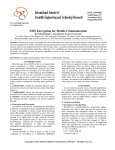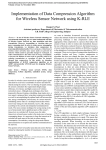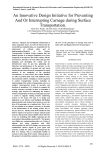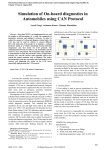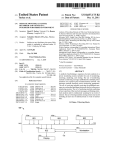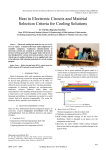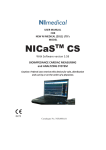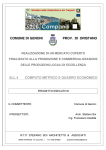Download Design of Velocity-Measuring System with Doppler Radar Concept
Transcript
ISSN: 2278 – 909X International Journal of Advanced Research in Electronics and Communication Engineering (IJARECE) Volume 1, Issue 4, October 2012 Design of Velocity-Measuring System with Doppler Radar Concept and FFT Algorithm Based On ARM Processor for Traffic Safety Mr. GUMMAREKULA SATTIBABU #1, Mrs. CH.SRIDEVI #2, Mr. T.SIVA SANKAR PHANI #3, Mrs. S.GANIKA SRIDEVI #4 #1 PG Scholar, Department of ECE, BVC Engineering College, Odalarevu, A.P. #2 Associate Professor, Department of ECE, BVC Engineering College, Odalarevu, A.P. #3 , # 4 Assistant Professor, Department of ECE, BVC Engineering College, Odalarevu, A.P. Abstract - The real-time monitoring of vehicles velocity has become essential for traffic safety. Since Traffic control is one of the largest challenges in cities and metros. Therefore, in turn to improve the method of monitoring the velocity of vehicles on road, this paper has designed a new radar based velocity measuring system which is based on ARM processor. This system uses the Doppler principle and spectral estimation FFT algorithm, in its hardware design part, and it takes full use of the underlying resources of ARM processor. The implementation of digital processor portion of the RADAR velocity measuring system is prototyped on ARM7 TDMI based LPC2148 microcontroller. The project aims to evolve a low cost DSP solution for such applications. The radar signal pretreatment block address all the issues involved with RADAR signal and finally generate the Doppler shift component, and it will be applied to ADC input of the ARM microcontroller. After analog to digital conversion FFT will be computed to find the frequency of the input signal. As the ARM7 doesn’t have any DSP blocks, for implementing FFT we develop routines in C. In the final stage of velocity computation the velocity is calculated based on the measured frequency component. The measured result will be displayed on LCD and the spectrum of the frequency will be sent to PC through serial port. The ARM7TDMI-NXP’s LPC2148 microcontroller is used for this task. Index Terms – ARM, Doppler effect, FFT algorithm Radar, Velocity-Measuring. I. INTRODUCTION The real-time monitoring of vehicles velocity has become essential for traffic safety. Because with the rapid development of the transportation industry, on the one hand, it promotes the economic and social prosperity, on the other hand, the modern intelligent traffic management and the traffic safety has been pushed to an unprecedented height. This extensive research topic has become an important world issue, and how to measure the velocity of vehicles is an important part of it. Speeding has been the main causation for traffic accidents, so the real-time monitoring of vehicles velocity has become essential for traffic management and traffic safety. At present, there are many ways of velocity measurement, including the coil method [3], image processing method [4], laser Doppler velocimetry [5], radar velocity-measuring system etc. [6]. The last two methods have been widely used due to its portability and high accuracy advantages. The laser Doppler velocimetry, though it has high accuracy, long effective distance advantages, but also has shortcomings, as only in the stationary state to use, easy to be found by driver, expensive and so on. The radar velocity-measuring system, signals are in larger and higher resolution and device can be moved from one place to another easily and can be used anywhere. Although it’s effective distance is less than the laser velocimetry, it also can meet the requirements of high accuracy and can be used in stationary and motion state, moreover it has become popular due to the mature technology and affordable price. As early as 1970s, western countries began to use radar velocity-measuring system, but these products are analog, large, and with low accuracy. To 1990s, a new radar velocity-measuring system appeared, which contained integrated circuits digital signal processor, and worked in the Ka-band, compared with the analog one, it has advantages of high accuracy, and small size [1]. In respect of implementation technology, several generations of radar velocity-measuring system has appeared with the development of microcontroller and microprocessor chip. The first generation product uses single chip to implement. This single chip needs to complete the control functions, also needs to complete the core algorithm of velocity-measuring system, but these algorithms are limited to a few simple, low-precision algorithms, such as counting cycles method and so on. The final product can achieve velocity measurement, but the accuracy is not enough, and the speed of systems operation is very slow. The second generation product uses single chip plus DSP (Digital Signal Processing) processor, which uses the traditional dual-core mode, that is, one single chip is to deal with the control system and another separate DSP processor is to complete the part of digital signal processing. This way can achieve the core algorithm that contains a large number of complex operations. The accuracy and speed of this generation products are much higher than the first generation products. With the emergence and extensive application of ARM processors, its rich peripheral control module and the underlying hardware resources make it possible to achieve the second generation product, that is to say, just use of ARM singlecore will be able to complete the traditional dual-core task, not only can greatly simplify the complex hardware design of the second generation product, but also have low cost, low power consumption advantages [2]. Therefore, the innovation of this paper lies in using ARM processor to 22 All Rights Reserved © 2012 IJARECE ISSN: 2278 – 909X International Journal of Advanced Research in Electronics and Communication Engineering (IJARECE) Volume 1, Issue 4, October 2012 achieve the radar velocity- measuring system. It can be used in traffic enforcement agency for measuring speeding violations, and will be a new trend in the development of the radar velocity-measuring system. II. THE STRUCTURE AND RELATED PRINCIPLES OF RADAR VELOCITY-MEASURING SYSTEM The ARM-based radar velocity- measuring system mainly includes two parts: radar signal pretreatment part and radar signal processing system. As millimeter wave radar has advantages of narrow angle, high resolution, antiinterference ability and small size these qualities of design of radar transceiver frontend is developed by the radar hardware simulation unit, which generates the frequency of the input signal within the range of ADC. As for the radar signal processing system, the specific design will be highlighted in Chapter 3. Firstly it will introduce the basic principles of radar velocity measurement and the signal processing principles in the radar signal processing system. 2.1 DOPPLER PRINCIPLES OF RADAR VELOCITY MEASUREMENT Measurement of the target velocity by radar mainly uses the Doppler Effect to carry out. The fixed-frequency electromagnetic waves which are launched by the radar transceiver front end will be bounced back when it encounters objects in the transmission process. If the encountered objects are stationary, then the frequency of bounced back waves will not change; If the encountered objects moved toward the direction of wave source, the waves bounced back at this time will be compressed, its frequency will increase; On the contrary, if the movement away from the wave source, the received echo frequency will be lower than the launch frequency [6]. Among them, the increase or decrease of frequency value is called the Doppler frequency, decided by the following equation: Where, fd is Doppler frequency, vr is the velocity of target vehicle, C is the speed of light, f0 is the launch frequency of radar wave. From (1) we can get: From (2) we can see other variables are known, as long as the Doppler frequency is worked out, we can calculate the target vehicle velocity. use of FFT algorithm is a kind of traditional spectral estimation, it is not only has the high accuracy of frequency estimation, but also can complete real-time signal processing. Therefore, we choose this method as the core algorithm of frequency measurement in the system. III. THE DESIGN OF RADAR SIGNAL PROCESSING SYSTEM Unlike DSP processor, ARM processor is not a dedicated digital signal processing chip, there is no single command to achieve the multiply-accumulate and parallel data access. However, with the ARM architecture fortified, making ARM slowly can be applied to many DSP applications. For ARM7TDMI and the beyond ARM processor, simply by careful clever software design, it can get a higher performance in digital signal processing section of the application system, while in the control part of the application system can also significantly better than DSP chips. Therefore, radar signal processing system based on ARM is entirely feasible, and it has simple hardware design, low cost and low power consumption advantages. Here we choose the LPC2148 NXP ARM chip to be the main processor of the system The system's hardware architecture mainly includes three parts: pretreatment part of the radar signal, digital signal processing part, and peripherals control part of the system 3.1 THE DESIGN OF RADAR SIGNAL PRETREATMENT PART The Protection circuit using in this project is to set the analog signals to reference voltage of 0v to 3.3v coming from the hardware simulation unit (function generator), as our microcontroller can work from a reference voltage of 0v to 3.3v. So if we get any voltage other than this amplitude the ADC of LPC2148 microcontroller cannot convert to digital. And also if we get any negative amplitude voltages this circuit converts to offset levels. The unit actually consists of two resistors, to give an offset voltage or reference voltage using voltage divider rule. As the two resistors values are same the converted voltage is half of the input voltage giving. So, as we give supply of 3.3 volts to this circuit it converts any other voltages to within the range of 0v to 3.3v by taking offset voltage as 1.65v i.e. reference voltage. Here every maximum positive peak of signal is 3.3v and every negative peak is with 0v and taking reference voltage as 1.65v. So, here we are using the capacitor to clipping the positive and negative peaks to block and set to reference voltage. The hardware block diagram of this part is shown in Figure.1. 2.2 THE SIGNAL PROCESSING PRINCIPLES OF THE SYSTEM From the above Doppler principles we can see that through estimating the Doppler frequency of radar echo signal, we can complete the velocity estimation of target vehicle. Among them, the measurement error of frequency directly affects the measurement results of velocity. The Figure 1 Hardware block diagram of the radar signal pretreatment part. 23 All Rights Reserved © 2012 IJARECE ISSN: 2278 – 909X International Journal of Advanced Research in Electronics and Communication Engineering (IJARECE) Volume 1, Issue 4, October 2012 The design of Radar signal pretreatment part is directly related to the back end software’s velocity measurement accuracy, that is, even if the back end frequency estimation algorithm is very accurate, as long as the radar signal’s pretreatment has a little distortion, it also will reduce the back end velocity measurement accuracy. 3.2 THE DESIGN OF SIGNAL PROCESSING AND PERIPHERALS CONTROL PART ARM processor is the core of these two parts of hardware design. First, through the radar signal pretreatment, the analog signal will be put into the ARM’s ADC module for sampling, convert into a digital signal, and then use ARM to carry out digital signal processing, ultimately use ARM control module to communicate with the PC, to set the speeding threshold value in the keyboard, to display the real-time velocity, to set speeding violation alarm by a buzzer and some other functions. The hardware block diagram of these two parts is shown in Figure. 2. 3.3.1 FFT ALGORITHM IMPLEMENTATION ON THE ARM PROCESSOR. FFT algorithm needs to handle a lot of floating-point operations, further more it has high requirements in the multiply-accumulate and data access aspect, while the ARM processor does not support hardware floating-point operations[12], and there is no single instruction to achieve multiply-accumulate and parallel data access. Forasmuch it is necessary to compare FFT’s various implementation ways and select a good method [11]. The Fourier transform of x(t) signal is given by formula X f x t e j2 ft dt If we consider x(t) function as sequence x(n) composed of N samples of input signal took by A/D converter than Fourier transform would be given so N 1 n 0 X m x n e j2 nm N It is a DFT formula. For real-world signals we assume that x(n) values are real numbers, which represent values of those signals given simply in volts. Figure 2 Hardware block diagram of these two parts The digital signal processing part fully uses the ARM’s underlying hardware resources, and it is achieved by software design, that is, the digital signal which is produced from the ADC module will use the spectrum analysis to estimate the frequency and velocity. This part will be adequately described in the following software design part; The design of the system’s peripherals control part, such as LCD circuit, PC and so on, they are common circuits, so this paper will no longer describe its composition. 3.3 THE SOFTWARE DESIGN OF RADAR SIGNAL PROCESSING SYSTEM The system's software design uses mixed programming which includes ARM assembly language and C programming language, in which the ARM assembly language is to achieve the key algorithm -- FFT algorithm; while pretreatment part of the radar signal and follow-up processing section of the spectrum analysis use C language for the program. The main task of radar digital signal processing systems software design is to carry out the sampling, operation pretreatment, spectrum operation, output and display of the operation results for the Doppler radar signal which passed from the radar hardware simulation unit. DFT result for input N samples of x(n) signal is set of N complex values X(m). The DFT formula could be simply used to compute spectrum of input signal. But let's watch how many complex multiplication operations had to be performed. To receive one value of X(m) sequence (for example X(1)) we should perform N multiplication operations. Since X(m) is a sequence of N complex numbers, the total number of complex multiplication 2 operations equals N . As written above, it turned out that many operations made while computing DFT are not necessary. In 1965, Cooley and Tuckey presented FFT N log 2 N complex algorithm, which needs only 2 multiplication operations for computing X(m) for N input values. Let's assume that we have to compute DFT of N=8192 samples. Using DFT we would have to perform approx. 1200 times more multiplication operations than while using FFT. Even for N=256 the gain is big. When we use FFT we have to perform 1024 multiplication operations instead 65536 when using DFT. FFT algorithm works well also for N not being integer power of 2. But in practice N often equals integer power of 2 and such version of FFT will be discussed [8]. Let's consider an example. Assume that N=8. Operations which have to be performed to compute 8-point FFT can be drawn in graphed form as shown at Figure 3. If two arrows' ends meet in one point, it means that number assigned to this point is sum of two numbers k assigned to begin of arrows' multiplied by W N . Of course, if no number is written on some arrow then it means multiplication by 1. 24 All Rights Reserved © 2012 IJARECE ISSN: 2278 – 909X International Journal of Advanced Research in Electronics and Communication Engineering (IJARECE) Volume 1, Issue 4, October 2012 Figure 3 8-Point FFT The butterfly simply represents following operations on complex numbers Figure 4 Hanning and Hamming functions k N x' x W y y' x W kN y Where x and y are input values, x' and y' are output values. As we can see there's one complex multiplication in one butterfly. Since in one stage we use N/2 butterflies and N stages, total number of complex N log2 N as multiplications in FFT algorithm equals 2 there are log 2 written earlier. Let's sum up by computing FFT for N samples of input signal x(n) sampled with some sampling frequency fs we received sequence of N complex numbers X(m) – the Fourier transform. But X(m) sequence directly doesn't consist any information about frequencies or voltages of FFT bins (bin is a value assigned to some m index). That's how FFT results should be interpreted [7]. Leakage phenomenon: Is price we pay for making smooth things discreet. One of methods of decreasing leakage's effects is windowing of input signals. It can be done by multiplying x(n) sequence's values by special window function. It ensures that signal values are the same (or very close) at begin (n=0) and at the end (n=N-1) of sampling time range. We have to remember that window function only decreases leakage's effects and do not eliminate them [9]. There is also no universal window function good for every purpose. There are dozens of window functions, everyone has different features. In practice Hanning and Hamming window functions are often used and spectrum analyzer described here provides both of them. Figure.4 shows Hanning and Hamming functions. Figure.5 shows an influence of Hanning window on DFT leakage [10]. Figure 5 Influence of Hanning window on DFT leakage. 3.3.2 IMPLEMENTATION OF SPECTRUM ANALYZER ON LPC2148 MICROCONTROLLER The main loop of spectrum analyzer software performs the following actions periodically in the microcontroller. Getting 256 samples of input signal; Multiplying samples by window function chosen by the user; Computing 256point FFT; Computing squares of absolute values of FFT result; Checking if any request came from PC; Sending spectrum when request received. This spectrum analyzer utilizes an ARM7 LPC2148 microcontroller to create an FFT algorithm while performing digital signal processing without the use of special DSP processor and it is shown in Figure 6. ARM7 25 All Rights Reserved © 2012 IJARECE ISSN: 2278 – 909X International Journal of Advanced Research in Electronics and Communication Engineering (IJARECE) Volume 1, Issue 4, October 2012 LPC2148 development board is used to set up the project as it is equipped with all necessary peripherals such as LCD interface, UART0/ UART1 and User Switches. The LPC2148 samples the input signal, with sampling frequency of 40 kHz, where a built-in analog to digital converter is used. Figure 6 ARM7 LPC2148 development board The 256-point Fast Fourier Transform (FFT) algorithm is performed after getting 256 samples of the signal. There are 256 complex numbers that comprise the result of FFT. The amplified spectrum of the signal comes from dividing the real and imaginary parts of those numbers by 128 and absolute values of them are displayed. The spectrum is sent to the PC via RS232 interface and the spectrum is displayed using specially created Windows application. For software developing I used Keil's uVision4 development environment along with ARM-GCC compiler. For flash programming the LPC2000 Flash Utility V2.2.1 has been used. 4. TEST RESULTS For testing the accuracy of the core algorithm, we have produced a fine tuned sinusoidal signal from a function generator and used this signal as a good pretreatment radar signals input to the ARM processor, then through the serial port, the Doppler frequency which is calculated by the program will be sent to the PC and displayed on the screen. The first diagram of Figure 7 shows the hardware results of measured velocity through the Doppler frequency component, the second diagram is a sinusoidal signal which is generated by function generator, from this diagram we can see that its frequency is 9.5 kHz, the third diagram is the value of frequency spectrum through the core algorithm, the measured signal frequency is 9.45 kHz. Compare with the true frequency 9.5 kHz, the frequency measurement accuracy of this algorithm is very high, which can reach more than 99%. The sampling points N in here are only 256. We can choose N=1024, 4096… in the program, then its frequency measurement accuracy will be higher. Figure 7 The result diagrams of the test 5. CONCLUSION In order to improve the method of monitoring the velocity of vehicles on road, this paper describes the radar based velocity measuring system design and algorithm research based on ARM7TDMI. The characteristics of this design are reflected by using single-core ARM processor to achieve the dual-core task which is traditionally completed by DSP plus single chip, and it has laid the foundation for ARM's DSP application. The test results show that the accuracy of this system can fully meet the requirements of traffic law enforcement agencies, and have the advantages of small size, low cost, low power consumption etc. Therefore, it entirely can be applied to traffic management departments in order to enhance the traffic safety. 26 All Rights Reserved © 2012 IJARECE ISSN: 2278 – 909X International Journal of Advanced Research in Electronics and Communication Engineering (IJARECE) Volume 1, Issue 4, October 2012 REFERENCES [1] Yi Zeng,Jianmin Xu and Deng Peng, “Radar Velocitymeasuring System Design and Computation Algorithm Based on ARM Processor.” IEEE 2010. [2] Andrew N.Sloss, Dominic Symes, Chris Wright, “ARM system developer’s guide: designing and optimizing system software,”American: Elsevier PteLtd, 2005, pp. 1-306. [3] Bruce R.Hellinga, “Improving freeway speed estimates from single-loop detectors,” Journal of Transportation Engineering, 2002, pp. 58-67. [4] Huei-Yung Lin, Kun-Jhih Li, Chia-Hong Chang, “Vehicle speed detection from a single motion blurred image,” Image and Vision Computing, 26, 2008, pp. 1327-1337. [5] LIU Chang-wen, LU Yao, LIU Jie, LU Fei, “Spectrumanalyzing laser velocimetric system,” Opto-Electronic Engineering, 31, 2004, pp. 52-55. [6] W.Kleinhempel, D.Bergmann, W.Stammler, “Speed measure of vehicles with on-board Doppler radar,” IEE Conference Publication Oct 12-13,1992, pp. 284-287. [7] Yun-Nan Chang, Keshab K.Parhi, “An efficient pipelined FFT architecture,” IEEE Transactions on Circuits and Systems II, 2003, 50(6),pp. 322-325. [8] Tanno K, Takeda T, Horiguchi S, “Parallel radix 4 FFT algorithms on an eight-neighbor processor array,” IEEE TENCON’92, 1992, pp. 855-859. [9] Yan Feng Li, Kui Fu Chen, “Eliminating the picket fence effect of the fast Fourier transform,” Computer Physics Communications, 178, 2008,pp. 486-491. [10] Richard G. Lyons “Understanding Digital Signal Processing” [11] “Fixed Point Arithmetic on the ARM” ARM DAI 0033A, Advanced RISC Machines Ltd (ARM) 1996 [pdf] [12] “Volume 1: LPC214x User Manual Rev. 01-15 August 2005 User manual”, Philips Semiconductors [pdf] 27 All Rights Reserved © 2012 IJARECE






